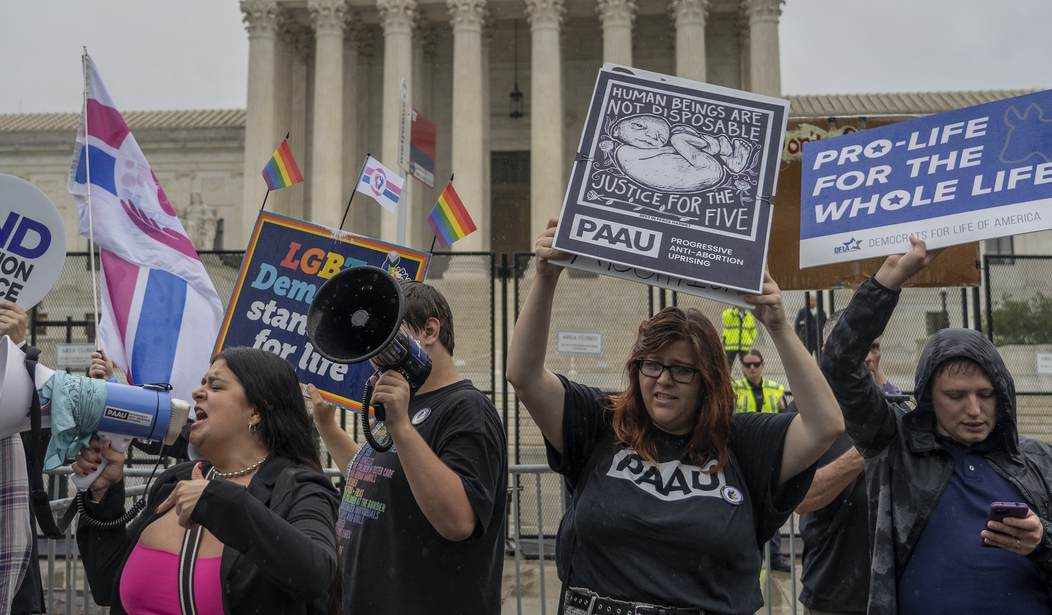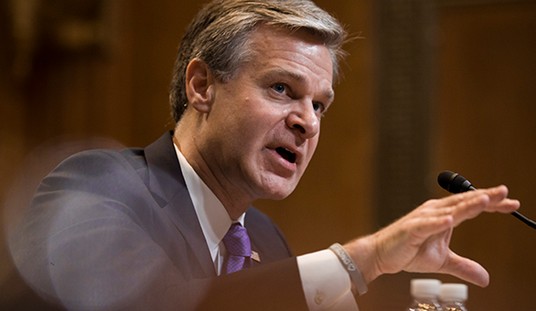The reign of Roe has come to an end, and with it the reign of Doe and Casey as well. The Supreme Court overturned Roe and all its successor precedents in a blockbuster ruling over an abortion-restricting law in Mississippi. The leaked draft opinion from Justice Samuel Alito turned out to be the controlling opinion, and all of the intimidation tactics didn’t apparently make any difference at all.
Biggest surprise here? Chief Justice John Roberts eventually came along for the ride, but we’ll get to that in a moment. Those who read the Alito draft will already be familiar with his argument:
We hold that Roe and Casey must be overruled. The Constitution makes no reference to abortion, and no such right is implicitly protected by any constitutional provision, including the one on which the defenders of Roe and Casey now chiefly rely—the Due Process Clause of the Fourteenth Amendment. That provision has been held to guarantee some rights that are not mentioned in the Constitution, but any such right must be “deeply rooted in this Nation’s history and tradition” and “implicit in the concept of ordered liberty.” Washington v. Glucksberg, 521 U. S. 702, 721 (1997) (internal quotation marks omitted).
The right to abortion does not fall within this category. Until the latter part of the 20th century, such a right was entirely unknown in American law. Indeed, when the Fourteenth Amendment was adopted, three quarters of the States made abortion a crime at all stages of pregnancy. The abortion right is also critically different from any other right that this Court has held to fall within the Fourteenth Amendment’s protection of “liberty.” Roe’s defenders characterize the abortion right as similar to the rights recognized in past decisions involving matters such as intimate sexual relations, contraception, and marriage, but abortion is fundamentally different, as both Roe and Casey acknowledged, because it destroys what those decisions called “fetal life” and what the law now before us describes as an “unborn human being.
Stare decisis, the doctrine on which Casey’s controlling opinion was based, does not compel unending adherence to Roe’s abuse of judicial authority. Roe was egregiously wrong from the start. Its reasoning was exceptionally weak, and the decision has had damaging consequences. And far from bringing about a national settlement of the abortion issue, Roe and Casey have enflamed debate and deepened division.
It is time to heed the Constitution and return the issue of abortion to the people’s elected representatives. “The permissibility of abortion, and the limitations, upon it, are to be resolved like most important questions in our democracy: by citizens trying to persuade one another and then voting.” Casey, 505 U. S., at 979 (Scalia, J., concurring in judgment in part and dissenting in part). That is what the Constitution and the rule of law demand.
Alito includes a long list of state-level prohibitions against abortion in Appendix A to emphasize how much Roe fell outside the “nation’s history and tradition.” The latest of those passed in 1952, only twenty-one years before Roe. The “history and tradition” argument worked the other way, which the Roe court ignored entirely in crafting a ‘right’ from its emanations and penumbras of the Fourth Amendment.
The biggest developments in this story come in the concurrences, and the fact that Alito held the majority together at all. The rage and intimidation was both political and very personal, with one justice — Brett Kavanaugh — the target of an assassination attempt. Kavanaugh’s concurrence amplifies Alito’s overall constitutional order argument, but also offers a limiting principle as to the reach of Dobbs:
After today’s decision, the nine Members of this Court will no longer decide the basic legality of pre-viability abortion for all 330 million Americans. That issue will be resolved by the people and their representatives in the democratic process in the States or Congress. But the parties’ arguments have raised other related questions, and I address some of them here.
First is the question of how this decision will affect other precedents involving issues such as contraception and marriage—in particular, the decisions in Griswold v. Connecticut, 381 U. S. 479 (1965); Eisenstadt v. Baird, 405 U. S. 438 (1972); Loving v. Virginia, 388 U. S. 1 (1967); and Obergefell v. Hodges, 576 U. S. 644 (2015). I emphasize what the Court today states: Overruling Roe does not mean the overruling of those precedents, and does not threaten or cast doubt on those precedents.
Second, as I see it, some of the other abortion-related legal questions raised by today’s decision are not especially difficult as a constitutional matter. For example, may a State bar a resident of that State from traveling to another State to obtain an abortion? In my view, the answer is no based on the constitutional right to interstate travel. May a State retroactively impose liability or punishment for an abortion that occurred before today’s decision takes effect? In my view, the answer is no based on the Due Process Clause or the Ex Post Facto Clause. Cf. Bouie v. City of Columbia, 378 U. S. 347 (1964).
We’ll have more on that in a moment.
But of course the big question rolling since the leak has been whither Roberts? The Chief Justice settled that today with a concurrence that advised “a more measured course,” saying that the court should have merely upheld the law in Dobbs without taking on the bigger issue of Roe:
I agree with the Court that the viability line established by Roe and Casey should be discarded under a straightforward stare decisis analysis. That line never made any sense. Our abortion precedents describe the right at issue as a woman’s right to choose to terminate her pregnancy. That right should therefore extend far enough to ensure a reasonable opportunity to choose, but need not extend any further— certainly not all the way to viability. Mississippi’s law allows a woman three months to obtain an abortion, well beyond the point at which it is considered “late” to discover a pregnancy. See A. Ayoola, Late Recognition of Unintended Pregnancies, 32 Pub. Health Nursing 462 (2015) (pregnancy is discoverable and ordinarily discovered by six weeks of gestation). I see no sound basis for questioning the adequacy of that opportunity.
But that is all I would say, out of adherence to a simple yet fundamental principle of judicial restraint: If it is not necessary to decide more to dispose of a case, then it is necessary not to decide more. Perhaps we are not always perfect in following that command, and certainly there are cases that warrant an exception. But this is not one of them. Surely we should adhere closely to principles of judicial restraint here, where the broader path the Court chooses entails repudiating a constitutional right we have not only previously recognized, but also expressly reaffirmed applying the doctrine of stare decisis. The Court’s opinion is thoughtful and thorough, but those virtues cannot compensate for the fact that its dramatic and consequential ruling is unnecessary to decide the case before us.
Let me begin with my agreement with the Court, on the only question we need decide here: whether to retain the rule from Roe and Casey that a woman’s right to terminate her pregnancy extends up to the point that the fetus is regarded as “viable” outside the womb. I agree that this rule should be discarded.
If that’s the case, though, it’s necessary to strike down Roe. Roe specifically drew that line, so it would require overturning that decision to get rid of the rule. Roberts’ position here sounds a bit like the old quote of having to demolish the village in order to liberate it. If you’re going to have to overturn a key element of Roe, and if — as Roberts argues — both Roe and Casey are bad con-law decisions, why keep them at all? Even if Roberts wanted to salvage the “right to choose” element from Roe and disentangle it from the “regulatory regime” it created around viability, that doesn’t address the core issues of constitutionality raised by Alito, Kavanaugh, and Clarence Thomas (about whom more in a moment). Rather than focus on the clear constitutional deficiencies of Roe and their poisonous impact on both politics and the judiciary, Roberts argues that the “serious jolt” to the legal system should have been avoided by having the court rejigger Roe rather than dispense with it and send the issue back to the states.
If Roberts wanted half-measures on this case, Thomas wanted to swing a sledgehammer to other precedents through Dobbs. He didn’t get his wish, but Thomas argued that the “substantive due process” argument that led to Casey has also led to a number of other judicial policymaking decisions that should also be dismantled, referencing a series of his own dissents on the matter:
The Court today declines to disturb substantive due process jurisprudence generally or the doctrine’s application in other, specific contexts. Cases like Griswold v. Connecticut, 381 U. S. 479 (1965) (right of married persons to obtain contraceptives)*; Lawrence v. Texas, 539 U. S. 558 (2003) (right to engage in private, consensual sexual acts); and Obergefell v. Hodges, 576 U. S. 644 (2015) (right to same-sex marriage), are not at issue. The Court’s abortion cases are unique, see ante, at 31–32, 66, 71–72, and no party has asked us to decide “whether our entire Fourteenth Amendment jurisprudence must be preserved or revised,” McDonald, 561 U. S., at 813 (opinion of THOMAS, J.). Thus, I agree that “[n]othing in [the Court’s] opinion should be understood to cast doubt on precedents that do not concern abortion.” Ante, at 66.
For that reason, in future cases, we should reconsider all of this Court’s substantive due process precedents, including Griswold, Lawrence, and Obergefell. Because any substantive due process decision is “demonstrably erroneous,” Ramos v. Louisiana, 590 U. S. ___, ___ (2020) (THOMAS, J., concurring in judgment) (slip op., at 7), we have a duty to “correct the error” established in those precedents, Gamble v. United States, 587 U. S. ___, ___ (2019) (THOMAS, J., concurring) (slip op., at 9). After overruling these demonstrably erroneous decisions, the question would remain whether other constitutional provisions guarantee the myriad rights that our substantive due process cases have generated. For example, we could consider whether any of the rights announced in this Court’s substantive due process cases are “privileges or immunities of citizens of the United States” protected by the Fourteenth Amendment. Amdt. 14, §1; see McDonald, 561 U. S., at 806 (opinion of THOMAS, J.). To answer that question, we would need to decide important antecedent questions, including whether the Privileges or Immunities Clause protects any rights that are not enumerated in the Constitution and, if so, how to identify those rights. See id., at 854. That said, even if the Clause does protect unenumerated rights, the Court conclusively demonstrates that abortion is not one of them under any plausible interpretive approach. See ante, at 15, n. 22. Moreover, apart from being a demonstrably incorrect reading of the Due Process Clause, the “legal fiction” of substantive due process is “particularly dangerous.” McDonald, 561 U. S., at 811 (opinion of THOMAS, J.); accord, Obergefell, 576 U. S., at 722 (THOMAS, J., dissenting).
Kavanaugh of course answered this in his own concurrence, at least in terms of Griswold, Obergefell, and similar cases. Alito mentioned the “treacherous field” of substantive due process in the controlling opinion as well, but argues that when it’s married to properly grasped history and tradition, it can be useful, and that’s it not a hindrance to reversing Roe:
In interpreting what is meant by the Fourteenth Amendment’s reference to “liberty,” we must guard against the natural human tendency to confuse what that Amendment protects with our own ardent views about the liberty that Americans should enjoy. That is why the Court has long been “reluctant” to recognize rights that are not mentioned in the Constitution. Collins v. Harker Heights, 503 U. S. 115, 125 (1992). “Substantive due process has at times been a treacherous field for this Court,” Moore v. East Cleveland, 431 U. S. 494, 503 (1977) (plurality opinion), and it has sometimes led the Court to usurp authority that the Constitution entrusts to the people’s elected representatives. See Regents of Univ. of Mich. v. Ewing, 474 U. S. 214, 225– 226 (1985). As the Court cautioned in Glucksberg, “[w]e must . . . exercise the utmost care whenever we are asked to break new ground in this field, lest the liberty protected by the Due Process Clause be subtly transformed into the policy preferences of the Members of this Court.” 521 U. S., at 720 (internal quotation marks and citation omitted).
On occasion, when the Court has ignored the “[a]ppropriate limits” imposed by “‘respect for the teachings of history,’” Moore, 431 U. S., at 503 (plurality opinion), it has fallen into the freewheeling judicial policymaking that characterized discredited decisions such as Lochner v. New York, 198 U. S. 45 (1905). The Court must not fall prey to such an unprincipled approach. Instead, guided by the history and tradition that map the essential components of our Nation’s concept of ordered liberty, we must ask what the Fourteenth Amendment means by the term “liberty.” When we engage in that inquiry in the present case, the clear answer is that the Fourteenth Amendment does not protect the right to an abortion.
Interestingly, the three liberal justices produced only one joint dissent. One would have thought each would want the opportunity to weigh in on this decision separately, but instead they combined to accuse the majority of depriving women of their rights and passing those off to legislatures:
Roe held, and Casey reaffirmed, that the Constitution safeguards a woman’s right to decide for herself whether to bear a child. Roe held, and Casey reaffirmed, that in the first stages of pregnancy, the government could not make that choice for women. The government could not control a woman’s body or the course of a woman’s life: It could not determine what the woman’s future would be. See Casey, 505 U. S., at 853; Gonzales v. Carhart, 550 U. S. 124, 171–172 (2007) (Ginsburg, J., dissenting). Respecting a woman as an autonomous being, and granting her full equality, meant giving her substantial choice over this most personal and most consequential of all life decisions.
Roe and Casey well understood the difficulty and divisiveness of the abortion issue. The Court knew that Americans hold profoundly different views about the “moral[ity]” of “terminating a pregnancy, even in its earliest stage.” Casey, 505 U. S., at 850. And the Court recognized that “the State has legitimate interests from the outset of the pregnancy in protecting” the “life of the fetus that may become a child.” Id., at 846. So the Court struck a balance, as it often does when values and goals compete.
That, however, is not the function of courts when it comes to policy. That is a legislative function, except when it crosses into enumerated constitutional rights and provisions. The minority wants to continue to argue for a judiciary that creates policy to solve issues of deep division within American society, but that is a task specifically and explicitly assigned to the legislative branch in the Constitution. The judiciary’s role is to apply law, not create regulatory-esque balancing schemes as public policy and then remove them from the reach of elected legislators. And the near-fifty years of chaos and jumbled judicial fiddling over issues like viability, access, and even free speech in the vicinity of abortion clinics prove just how correct the framers of the Constitution were to separate those functions.
Now that Roe is finished, legislators can finally start to pick up the threads of a process locked in stasis for the last five decades. I spoke with Austin Ruse of the Center for Family & Human Rights in my latest podcast about what comes next. He fears that the US will settle into the European model of abortion, which would still be an improvement over the status quo in the US, but would leave a lot of babies dead in the future too.








Join the conversation as a VIP Member